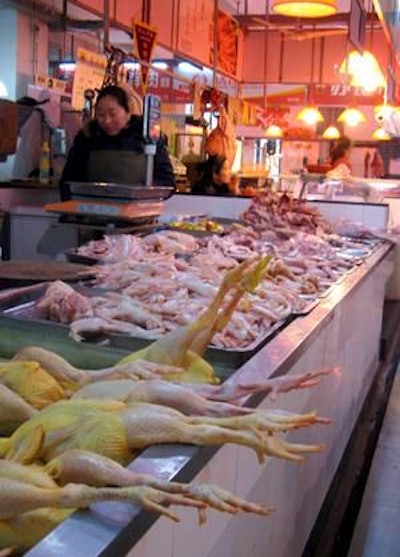
Over the past decade, Chinese consumers have changed their chicken buying habits increasing the amount of chicken they eat and expanding the places they get it from. But some things stay the same such as affection for chicken feet.
Total annual poultry consumption for urban residents increased from 7.5 pounds per capita in 1990 to 18.3 pounds per capita in 2006, an increase of 244%, according to the latest data available from China's Ministry of Statistics. The annual poultry consumption for rural residents increased from 2.75 pounds per capita in 1990 to 7.7 pounds per capita in 2006, an increase of 281%.
Protein power
Fifteen years ago, Wang Yuefei only ate chicken on important holidays, fighting with her sister over second helpings. However, today, as a sales representative at an international cosmetics company in Beijing, Wang can eat chicken every day because she can afford it.
China's poultry consumption increased over the last decade along with that of other meats due to rising incomes, experts said. And the trend is expected to continue in 2009, because of lower prices of poultry products.
There is plenty of room for growth
"Rising incomes will drive the meat consumption growth in areas where per capita income is below $5,000," Wang Zhicai, secretary of the Animal Husbandry Department of China's Ministry of Agriculture, said in an interview with the state-owned People's Daily newspaper. "China's per capita income just reached $2,000 in 2007. As a result, China still has huge potential for poultry consumption."
In addition, as Chinese people get richer, they pay more attention to their health and start to choose poultry over pork, the traditional protein staple in China.
"An increasing number of Chinese, especially young people, want to eat more poultry now," said Hu Hao, an agribusiness professor at the Nanjing-based Agriculture University. "Poultry meat has less fat and more protein than pork."
As a result, in urban areas, the growth rate of per capita poultry consumption by weight was 244% from 1990 to 2006 while the growth rate for per capita pork consumption by weight was 108% during the same period, according to the statistics published by China's Ministry of Statistics. In rural areas, the growth rate of per capita poultry consumption by weight and pork consumption by weight were 356% and 147% respectively, from 1990 to 2006.
Meanwhile, for reasons of convenience and out of safety concerns, richer Chinese could buy poultry meat in more expensive places such as supermarkets and restaurants. Traditionally, poultry was sold live or freshly killed in un-refrigerated, open-air "wet markets," and these wet markets still exist in cities and towns around China.
However, chickens bought there require quite a bit of work on the part of the cook. Supermarket chicken, however, can be bought not just whole but also cut up or packaged with vegetables and ready to cook, or already cooked and ready to eat.
"As many Chinese are busy with their jobs, they can not spend a whole day cooking like their parents did," Guo Huiyong, an analyst at the Beijing-based Orient Agribusiness Consultant Ltd., said. "Instead of cooking at home, many Chinese, especially young people, eat poultry outside or buy ready-to-cook chicken from supermarkets."
Poultry consumption at fast food outlets, restaurants and hotels increased from 4.4 million metric tons in 1998 to 7 million metric tons in 2008, and its market share of total poultry consumption also went up from less than 30% in 1998 to 44% in 2008, according to Guo.
Changing channels
Last Thanksgiving, after eating turkey with her foreign colleagues for the first time, Wang, the Beijing sales representative, decided to never try it again.
"I am not against turkey," Wang said. "But I am not really used to its taste. Actually, I am quite curious to try Western food as long as it tastes good to me."
Maybe some new recipes could help. Kurt Markham, for example, a marketing director at Minnesota Department of Agriculture, says his department, together with the Wuxi-based Southern Yangtze University, has been working on adapting Chinese recipes for use with turkey. Chinese-style turkey recipes include steamed turkey wrapped in lotus leaves, turkey soup with gingko nuts and Kung Pao turkey diced turkey with peanuts and hot red peppers, similar to the popular Kung Pao chicken .
"Chinese customers gave positive feedback to the new Chinese-style turkey products," Feng Meiqian, a spokesperson for the Minnesota Turkey Growers Association, said. "I ate a turkey sandwich before, but this was my first time to try Chinese-style turkey. It was quite special and tasty."
Hormel's subsidiaries in Shanghai and Beijing have been selling the Jennie-O Turkey Store products. In order to help Chinese customers understand how to use this new product, Hormel posts recipes for its ground turkey and other foods on the company's Chinese Web site.
Poultry producers see results
"My company focuses on cooperation with big clients like KFC because we want to benefit from their fast development," Chen Jianhua, a spokesman at Fujian-based Sunner Co. Ltd., said. "The total production in my company reached 60 million chickens last year but our product was still in short supply."
Chinese stores are filled with chicken heads, feet (paws), internal organs even blood.
Zhang Fengfeng, a 30-year-old woman from Jiangsu province, likes eating chicken paws when she watches television with her husband. "Chicken paws are my favorite snack," Zhang said. "I eat them like Westerners eat potato chips."
Foreign producers are meeting the demand for these chicken parts, with increasing exports to China.
Although exact numbers aren't available, Orient Agribusiness' Guo estimated that China's annual poultry imports are now up to 600,000 metric tons, accounting for about 33% of total poultry parts consumption. In 2007, China's paw imports which accounts for 51% of total chicken imports reached 396,000 metric tons, an increase of 37% compared to 2006.

















